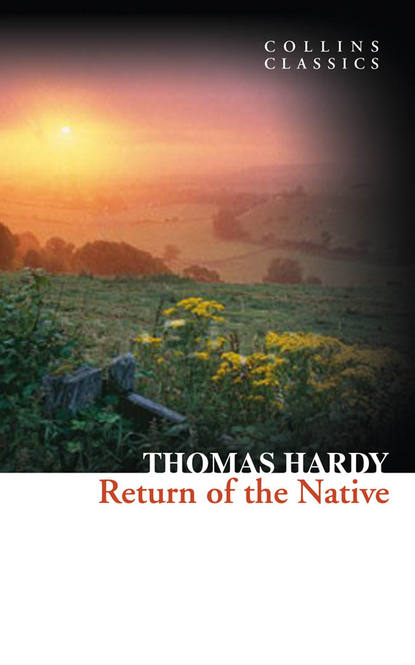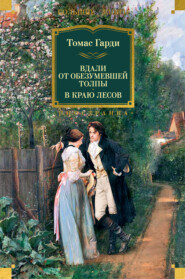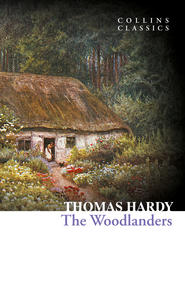По всем вопросам обращайтесь на: info@litportal.ru
(©) 2003-2025.
✖
Return of the Native
Настройки чтения
Размер шрифта
Высота строк
Поля
Chapter 2: A Lurid Light Breaks in upon a Darkened Understanding (#litres_trial_promo)
Chapter 3: Eustacia Dresses Herself on a Black Morning (#litres_trial_promo)
Chapter 4: The Ministrations of a Half-forgotten One (#litres_trial_promo)
Chapter 5: An Old Move Inadvertently Repeated (#litres_trial_promo)
Chapter 6: Thomasin Argues with Her Cousin, and He Writes a Letter (#litres_trial_promo)
Chapter 7: The Night of the Sixth of November (#litres_trial_promo)
Chapter 8: Rain, Darkness, and Anxious Wanderers (#litres_trial_promo)
Chapter 9: Sights and Sounds Draw the Wanderers Together (#litres_trial_promo)
BOOK SIX—AFTERCOURSES (#litres_trial_promo)
Chapter 1: The Inevitable Movement Onward (#litres_trial_promo)
Chapter 2: Thomasin Walks in a Green Place by the Roman Road (#litres_trial_promo)
Chapter 3: The Serious Discourse of Clym with His Cousin (#litres_trial_promo)
Chapter 4: Cheerfulness Again Asserts Itself at Blooms-End, and Clym Finds His (#litres_trial_promo)
Footnotes (#litres_trial_promo)
Classic Literature: Words and Phrases adapted from the Collins English Dictionary (#litres_trial_promo)
Copyright (#litres_trial_promo)
About the Publisher (#litres_trial_promo)
History of Collins (#ulink_5f31ea3c-738f-5282-aff0-b31b118036fc)
In 1819, millworker William Collins from Glasgow, Scotland, set up a company for printing and publishing pamphlets, sermons, hymn books and prayer books. That company was Collins and was to mark the birth of HarperCollins Publishers as we know it today. The long tradition of Collins dictionary publishing can be traced back to the first dictionary William published in 1824, Greek and English Lexicon. Indeed, from 1840 onwards, he began to produce illustrated dictionaries and even obtained a licence to print and publish the Bible.
Soon after, William published the first Collins novel, Ready Reckoner, however it was the time of the Long Depression, where harvests were poor, prices were high, potato crops had failed and violence was erupting in Europe. As a result, many factories across the country were forced to close down and William chose to retire in 1846, partly due to the hardships he was facing.
Aged 30, William’s son, William II took over the business. A keen humanitarian with a warm heart and a generous spirit, William II was truly ‘Victorian’ in his outlook. He introduced new, up-to-date steam presses and published affordable editions of Shakespeare’s works and ThePilgrim’s Progress, making them available to the masses for the first time. A new demand for educational books meant that success came with the publication of travel books, scientific books, encyclopaedias and dictionaries. This demand to be educated led to the later publication of atlases and Collins also held the monopoly on scripture writing at the time.
In the 1860s Collins began to expand and diversify and the idea of ‘books for the millions’ was developed. Affordable editions of classical literature were published and in 1903 Collins introduced 10 titles in their Collins Handy Illustrated Pocket Novels. These proved so popular that a few years later this had increased to an output of 50 volumes, selling nearly half a million in their year of publication. In the same year, The Everyman’s Library was also instituted, with the idea of publishing an affordable library of the most important classical works, biographies, religious and philosophical treatments, plays, poems, travel and adventure. This series eclipsed all competition at the time and the introduction of paperback books in the 1950s helped to open that market and marked a high point in the industry.
HarperCollins is and has always been a champion of the classics and the current Collins Classics series follows in this tradition – publishing classical literature that is affordable and available to all. Beautifully packaged, highly collectible and intended to be reread and enjoyed at every opportunity.
Life & Times (#ulink_2d41ee98-da76-5db6-b96b-7daaf203dd96)
About the Author
Thomas Hardy was born in a Dorset village in 1840. Although he had a modest upbringing, Hardy found himself working successfully as an architect in London at the age of 22. He spent five years in London, but was eventually drawn back to Dorset because he did not enjoy the urban environment or the class prejudice he felt, mixing with the well-heeled of England’s capital city. Having returned to the countryside, he began to consider an alternative career as a novelist. By 1867 he had already completed a manuscript, but had no luck placing it with a publisher. Despite this, his ambition knew no bounds and he persevered securing his first publication in 1871. His first five novels were well received and Hardy’s confidence in pushing the literary envelope grew steadily.
Hardy’s Works
Most of Hardy’s work is set in a semi-fictional region called Wessex. The name comes from the Anglo-Saxon Kingdom of Wessex, which was eventually fragmented following the invasion of William the Conqueror in 1066. In his imaginary Wessex, Hardy gives many real places alternative names as if it were a kind of parallel universe. This was Hardy’s devise, partly to make it abundantly clear that his work was not about real people and places, but also to provide a world into which he could escape as a writer.
In Far From the Madding Crowd, published in serial form in 1874, Bathsheba is his beautiful female protagonist and it is through her experiences that Hardy exposes his feelings on romantic love and the inconsistency and destruction that can be caused by relationships. However, the central concern of Far From the Madding Crowd highlights Hardy’s preoccupation with the modernity and industrialization of society. Many of his texts are set in rural locations and Hardy details the dialects, landscape, and people of the English countryside to try and preserve that history and endangered way of life. Central to Hardy’s overall ambition was to show that living people are only ever custodians of the world for future generations. Dorset is filled with ancient sites of human activity and prehistoric evidence of a past without humanity. Hardy wanted to make it clear that we each have a window of opportunity in life to make our mark. That is why he had little time for people whom he considered to be fatuous or self-interested, because he was acutely aware that it is the impression that we make on others that counts the most, both during life and after death.
The Return of the Native (1878), Hardy’s sixth novel, is arguably his finest work and one of the best novels ever written. At the time of its publication, its themes were viewed as rather controversial, due to the sensibilities of Victorian polite society. In truth, it was a novel of insightful realism, about human nature leading people to make foolish decisions that bring about their own unhappiness and leave victims in their wake. As a literary work, The Return of the Native is impressive in its use of prose. Hardy evokes the environment and mood of Egdon Heath in exacting detail. The writing is also steeped in metaphor and classical reference, with every paragraph considered and crafted to perfection.
The anti-heroine of the story is Eustacia Vye, a shallow, vain young woman who imagines a high-society life in London and makes no effort to fit into the Wessex community in which she is immersed. She also happens to be exquisitely beautiful – a femme fatale to the eligible young men who cross her path. This is a trope often used by Hardy. His rather black-and-white view of attractive women was that physical beauty often masked inner ugliness –a beguiling combination to lustful men.
Clement Yeobright, the central character, is an earthy school teacher who returns to the area having seen a bit of the world – he is the returning native of the title. He falls for Eustacia’s beauty, unable to see that his cousin, Thomasin, is better suited to his needs. Ultimately Eustacia shows her true colours when she realizes that Clement is content to remain living in Egdon Heath. She attempts to elope with Thomasin’s first husband, the womanizer Damon Wildeve, but both are drowned in a weir by Hardy’s pen. Clement continues life alone, while Thomasin marries Diggory Venn, an admirer who has protected Thomasin’s interests throughout the story.
The novel was considered risqué in the 19th century because it dealt with marriage failure and sexual liaison out of wedlock, both of which were real-life issues, of course, but were brushed under the Victorian carpet. As values shifted during the 20th century, readers began to realize what a masterpiece Hardy had produced. Fundamentally, The Return of the Native is an allegory about what people can expect from life when they lack the wisdom to pursue what is best for them and choose instead to satisfy their primal desires and vanities. Hardy also rewards those who do have wisdom, and his themes still ring true today, which is perhaps why the novel is so highly regarded.
In 1886 Hardy published The Mayor of Casterbridge. At a country fair, Henchard, Hardy’s tragic hero, auctions off his wife and daughter when he’s drunk. He spends most of his life repenting for this act and eventually becomes an upstanding citizen of Casterbridge, a successful businessman and mayor of the town. Impulsive and volatile, yet emotional and repentant, when his wife and daughter return to Casterbridge Henchard attempts to make amends. Throughout the novel, Hardy focuses on the importance of reputation and good character and demonstrates how the present is always haunted by the past and cannot be denied. Particularly Hardy-esque in nature is the great tension that is set up between Henchard’s public and private life in a small rural town where the community act as judge and jury on the flaws and mistakes of those among them.
Hardy’s best-known novel, Tess of the D’Urbervilles, was published in 1891. The eponymous Tess starts out as an innocent peasant girl, but embarks on a tragic life tale that ultimately ends in her execution for murder. For Hardy the story was an examination of how the individual can wind up in such desperate and forlorn situations even when their beginnings are much the same as others people’s. Again, like Eustacia, Tess is physically attractive and her ambitions lead her into scenarios that make her life ever more complicated and unsettled. This includes a scene in the first chapter when Tess loses her virginity but is seemingly too naive to understand whether she consented or was raped.
Hardy’s Literary Legacy
In many respects the literature of Thomas Hardy is quintessentially English in tone and content. His stories are set in the deepest rural and bucolic southwest, where time attempts to stand still, preserving an English idyll that was worlds apart from the industrialization of the 19th century. For this reason his novels are described as belonging to the genre of ‘naturalism’.
Hardy was primarily concerned with the innate nature of personalities in his literature. He ascribed each character with a personality type which largely predetermined their fate. While other authors, such as Charles Dickens, conveyed the idea that people can learn from their mistakes and change, Hardy showed the opposite. For Hardy, people never really learn the error of their ways and fate will deal them their hand in proportion to their level of selfishness, vanity, pride, foolishness, arrogance, unkindness or other failing. In some cases Hardy even resorts to having troublesome characters killed off or removed to prison in order to restore harmony. In this way he gives the more deserving the opportunity to alter their circumstances for the better.
One might think that Hardy was religious, given this moral and ethical filter, but he wasn’t particularly interested in religion. He was more taken by the idea of allowing his characters to express superstitions and supernatural beliefs. In this regard he was really adopting the view of the anthropologist, who remains necessarily impartial on matters of belief, so that they can study people with neutrality. His work is also filled with subtle allusions to Classical references, which he used to underpin central characters.
Hardy used to search for events reported in newspapers and often used them in his plots. It wasn’t so much that he lacked the imagination to think up ideas, but that he wanted to inject a sense of realism by introducing elements that simply would not have occurred to him. Real life can sometimes be stranger than fiction. Quite apart from anything else, Hardy had an eye for the tragedy of life. He was a humanist, who cared about the underdog and expressed this by dealing with those who were more privileged in his prose.
PREFACE (#ulink_6c566f58-de97-5690-931d-175760d06800)
The date at which the following events are assumed to have occurred may be set down as between 1840 and 1850, when the old watering place herein called “Budmouth” still retained sufficient afterglow from its Georgian gaiety and prestige to lend it an absorbing attractiveness to the romantic and imaginative soul of a lonely dweller inland.
Under the general name of “Egdon Heath”, which has been given to the sombre scene of the story, are united or typified heaths of various real names, to the number of at least a dozen; these being virtually one in character and aspect, though their original unity, or partial unity, is now somewhat disguised by intrusive strips and slices brought under the plough with varying degrees of success, or planted to woodland.
It is pleasant to dream that some spot in the extensive tract whose southwestern quarter is here described, may be the heath of that traditionary King of Wessex—Lear.
July, 1895.
“To sorrow
I bade good morrow,
And thought to leave her far away behind;
But cheerly, cheerly,
She loves me dearly;

















